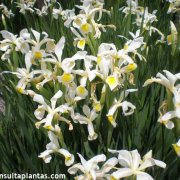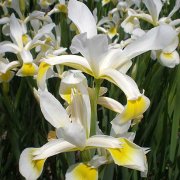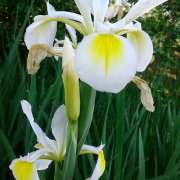Care of the rhizomatous plant Iris orientalis or Turkish iris |
|
The genus Iris, family Iridaceae, comprises 300 species of rhizomatous and bulbous plants native to temperate regions of Europe, Asia, Africa and America. Some species are: Iris orientalis, Iris germanica, Iris foetidissima, Iris pseudacorus, Iris unguicularis, Iris pumila, Iris aucheri, Iris xiphium, Iris lutescens. Common names: Turkish iris, Yellow banded iris. This species is native to the eastern Mediterranean and the Middle East. They are rhizomatous herbaceous plants with long erect sword-shaped leaves 1 meter (39.37") in length. The showy and fragrant flowers are white with yellow tones. They bloom from mid-spring to early summer; they may not flower the first year. Produces elliptical fruits. Turkish iris is used to form groups, in rockeries and borders. It's very appreciated for cut flowers. Iris orientalis can grow in full sun or semi-shade exposure. It resists frost down to -4 ºC (24.8 ºF). They prefer calcareous soils but can grow in well-drained soil with a little organic matter. The rhizomes are planted in late summer. Water moderately, waiting for the substrate to dry. Yellow banded iris resists several days of drought. Fertilize with compost in late winter. Prune flowers and withered leaves after flowering. Iris orientalis is a plant resistant to the usual pests but sensitive to excess humidity. Turkish iris propagates from seeds sown in spring or autumn and by division of the rhizome in late summer. |
Images of the rhizomatous plant Iris orientalis or Turkish iris |
Find plants
Iris orientalis or Turkish iris | Care and Growing
© 2025 FavThemes


